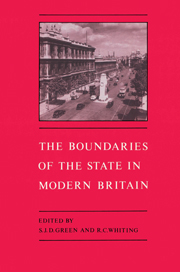Book contents
- Frontmatter
- Contents
- List of figures
- List of tables
- List of contributors
- Acknowledgements
- 1 Introduction: the shifting boundaries of the state in modern Britain
- Part I The state and political theory
- Part II The economy
- 6 The size and scope of the public sector
- 7 The boundaries of taxation
- 8 Economic knowledge and the state in modern Britain
- Part III Welfare and social policy
- Part IV Conflict and order
- Part V Religion and morality
- Index
6 - The size and scope of the public sector
Published online by Cambridge University Press: 18 March 2010
- Frontmatter
- Contents
- List of figures
- List of tables
- List of contributors
- Acknowledgements
- 1 Introduction: the shifting boundaries of the state in modern Britain
- Part I The state and political theory
- Part II The economy
- 6 The size and scope of the public sector
- 7 The boundaries of taxation
- 8 Economic knowledge and the state in modern Britain
- Part III Welfare and social policy
- Part IV Conflict and order
- Part V Religion and morality
- Index
Summary
Introduction
The expansion of the public sector and the growth of big government have been common features of all twentieth-century economies and political systems, whether they be advanced western industrial market economies, centrally planned socialist states, newly industrialising countries or less developed economies. Although the British case conforms broadly to the experience of the advanced industrial economies, there are important differences. This is particularly true in respect of the comparative size of Britain's public sector, the composition of public expenditure and revenue, and the timing of its critical phases of growth. As a consequence, the British case has been frequently misunderstood. In particular, the focus upon aggregate measures of state activity has resulted in insufficient attention being paid to the composition of public expenditure and the implications of this for equity and efficiency in the British economy and the underlying objectives of public policy-makers. This chapter thus follows the tradition, which runs from the early twentieth-century German fiscal sociologists through to modern public choice theory, that public finance, by representing the ‘hard, naked facts’, offers ‘one of the best starting points for an investigation of society’.
The first objective of this chapter is thus to chart the long-run growth of the public sector using a variety of indicators and to assess this in relation to comparable economies. With this established, explanations of public sector growth and their applicability to the British case are then examined.
- Type
- Chapter
- Information
- The Boundaries of the State in Modern Britain , pp. 89 - 145Publisher: Cambridge University PressPrint publication year: 1996
- 1
- Cited by



